Hobo spiders are generally considered some of the creepiest spiders out there. That’s because they like to hide in small, dark crevices where they lay their eggs in funnel-shaped webs, making some areas of peoples’ homes the ideal spot for these spiders.
What is a Hobo spider and is it venomous? A Hobo spider is a small, fast funnel-web spider that stays close to the ground. They were previously thought to be very venomous, that is why it is important to learn more about the severity of their poison and how to get rid of them.
In this article, we’ll tell you everything you need to know about hobo spiders and how to get rid of them. We’ll also show you some of the go-to ways for eliminating these spiders from homes and outdoor areas so you won’t have to worry about them invading your private spaces ever again.
Hobo Spider Identification, Behavior and Control
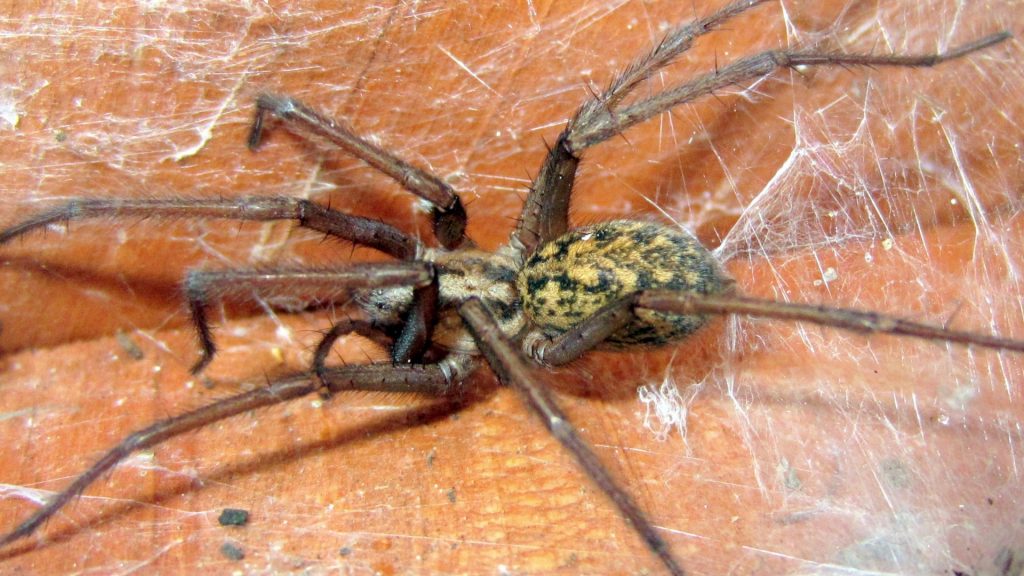
The hobo spider, Eratigena agrestis, is a small brown spider with long legs and a flat, circular body. It spins funnel-shaped webs. In the USA, it lives in the pacific northwest.
Did you know that hobo spiders are called “hoboes”? This is because they travel from place to place on ships, trains, and cars.
They are initially from Europe, but they have spread to other regions with similar climates where they eat other spiders and take over the population.
Hobo spiders are notoriously hard to identify since there are so many other spiders that look very similar. One of the only ways to positively identify hobo spiders is using a microscope, and not many people want to get that close to one of these spiders.
Related: Are Spiders Insects (Bugs), Arachnids, Mammals, or Reptiles?
What Do Baby Hobo Spiders Look Like?
Baby hobo spiders are often misidentified as house spiders since hobo spiders look much like other common arachnids. They are dark brown with long legs, and they scoot across the ground at high speeds.
How Big Can Hobo Spiders Get?
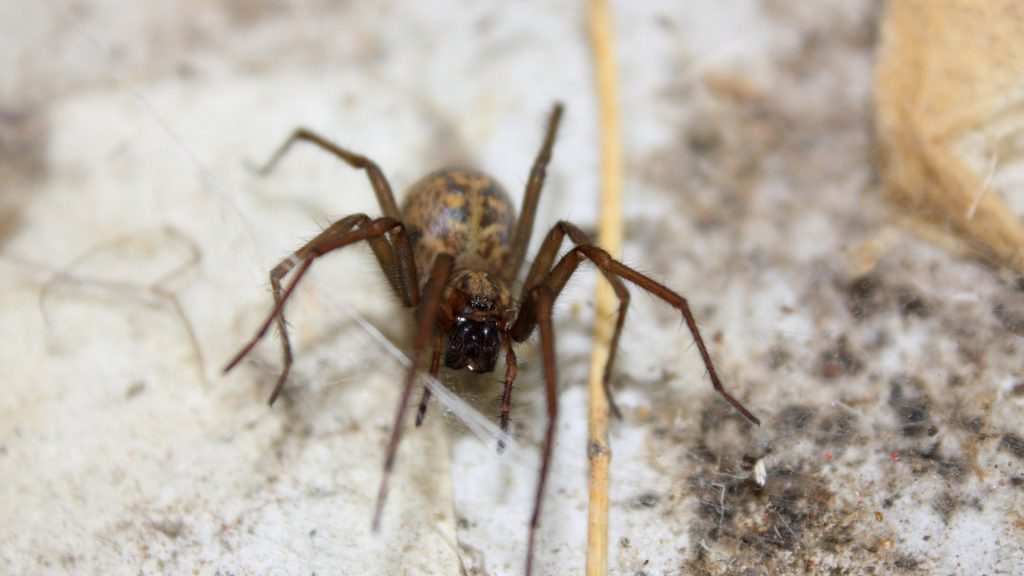
According to experts at Utah State University, female hobo spiders are between 9.5 and 16.5 mm (3/8-5/8 in) long, and male hobo spiders are between 7 and 13.5 mm (9/32-9/16 in). Hobo spiders have a leg span between 2 and 3 inches (5 – 7 cm).
How Many Eyes Do Hobo Spiders Have?
Hobo spiders have eight eyes arranged in two separate rows of four. But though they have eight eyes, hobo spiders have poor vision and can only see objects a few feet (75 cm) away.
This sometimes causes them to scurry towards people who think the hobo spider attacks them when the spider is not even aware of their presence.
Types of Hobo Spiders
There is only one type of hobo spider. Its scientific name is Eratigena agrestis, but it used to belong to the Tegenaria family. The word agrestis means “of the field” in Latin since these spiders often live in shrubs, dense grasses, bushy trees, and underneath rocks and logs.
Where Do Hobo Spiders Live?
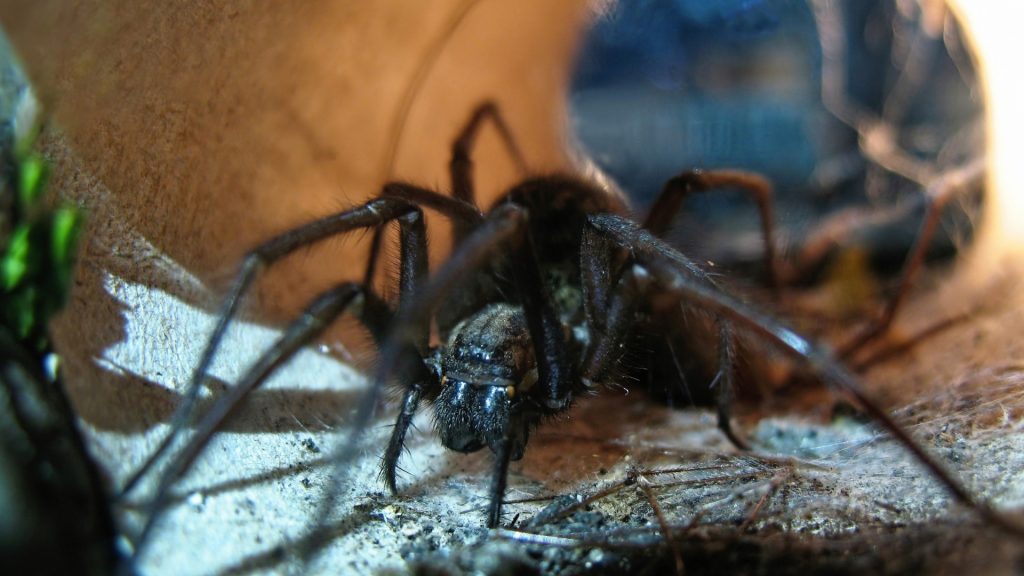
In the USA, hobo spiders live in the Pacific Northwest. Generally, you can find them in British Columbia, Washington, Oregon, Colorado, Wyoming, Utah, northern Idaho, and Montana.
How Long Do Hobo Spiders Live?
Generally, hobo spiders live for around one year, but they can live for three years in warmer climates. Still, male hobo spiders die immediately after mating, so they never live as long as females.
Do Hobo Spiders Make Nests?
Hobo spiders make nests out of their silky threads. They usually lay 50-100 eggs in each clutch which they spin a thick, white web over and attach to the undersides of leaves, logs, or stones. They lay their eggs in these webs.
The female lays her eggs in several white to cream-colored sacs which hang from the web.
Related: How To Get Rid of a Spider Nest?
Can Hobo Spiders Climb?
Hobo spiders can climb up carpeted or rough surfaces but with some difficulty since they are not good climbers. A hobo climber can climb up to a height of about four feet (1.2 m) if a surface is sufficiently rough or porous to let it get a grip.
Can Hobo Spiders Jump?
Hobo spiders can jump, but not very well. According to arachnologists at Utah State University, they are swift, though, and they travel 0.45 meters (17 inches) per second on average.
What Do Hobo Spiders Eat?
Hobo spiders eat flies, other spiders, crickets, and various insects that they can catch in their webs. Anything small enough to get entangled in a hobo spider’s funnel-shaped web will likely end up on the hobo spider’s menu.
How Dangerous Are Hobo Spiders?
No one knows exactly how dangerous hobo spiders are. Some people believe that they may cause necrosis or the death of tissues at the site of a bite. However, many scientists and scholars still debate whether hobo spiders are venomous since they rarely inject venom into human beings.
Many people believe that hobo spider bites cause necrosis, or decaying flesh, in human beings. However, this fact has never been confirmed by health professionals or arachnologists.
So, no one knows how poisonous hobo spiders are, but we know some things about their levels of aggression and what happens if they inject venom into a human.
Are Hobo Spiders Aggressive?
Hobo spiders are often referred to by the common name “aggressive house spider,” but they are not aggressive. Hobo spiders may bite when physically threatened, but their first instinct is to run when they spot a human.
Do Hobo Spiders Bite?
Hobo spiders bite when they feel threatened. However, hobo spiders rarely bite people, which is part of why spider experts are still unsure whether hobo spiders are dangerous or not.
So, unless you try to pick up a hobo spider or get one stuck beneath your clothes, it is improbable that it would bite you.
Related: Can Spiders Bite Through Leggings?
Are Hobo Spiders Poisonous?
While the CDC once considered hobo spiders as venomous, they no longer list hobo spiders as venomous spiders. The only verified venomous spiders in the USA are black widows and brown recluse spiders.
In the 1980s, several scientific reports indicated that some brown recluse spider bites might have been misdiagnosed and were actually hobo spider bites. However, there were no hard facts to back up this claim – it was all conjecture.
More recent studies from 2011 revealed that it is unlikely that the hobo spider can cause necrosis. In addition, the results suggested that the venom of a hobo spider is no more harmful than that of a bee or wasp.
Nowadays, many spider experts believe that hobo spider bites are relatively harmless. Still, some experts believe that only the male hobo spiders can affect humans, and if left untreated, the bite may result in necrotic tissue.
So, while some scholars and scientists believe that hobo spider bites are pretty harmless, others believe they are very harmful. Unfortunately, because of the potential danger, no one has tested the effect of the bites on humans in a scientific setting, leaving the debate unresolved at this point.
If you feel a painful spider bite or notice a swelling or white blister, always try to trap or photograph or trap the spider and go to a doctor immediately. If hobo spiders indeed cause necrosis, leaving the bite untreated could result in dire consequences such as amputation.
Can Hobo Spiders Kill You?
It is improbable that a hobo spider bite could kill you. Still, since no one is entirely positive about the toxicity of hobo spiders, you should immediately go to a doctor if you are bitten by one.
Right now, biologists and medical doctors need more evidence regarding hobo spiders’ venom. So, it is always a good idea to keep a spider if it bites you. Then, bring the spider to a doctor, especially if your body reacts to the bite.
What Attracts Hobo Spiders?
Hobo spiders are attracted to warm, dry places like closets and attics. They most often come indoors by accident while looking for a mate or following other insects inside homes.
Generally, no one wants a hobo spider in their home. These spiders are frightening and of dubious harmfulness to humans.
So, why would a hobo spider come inside your house, and what do they want from you?
How Do Hobo Spiders Get in the House?
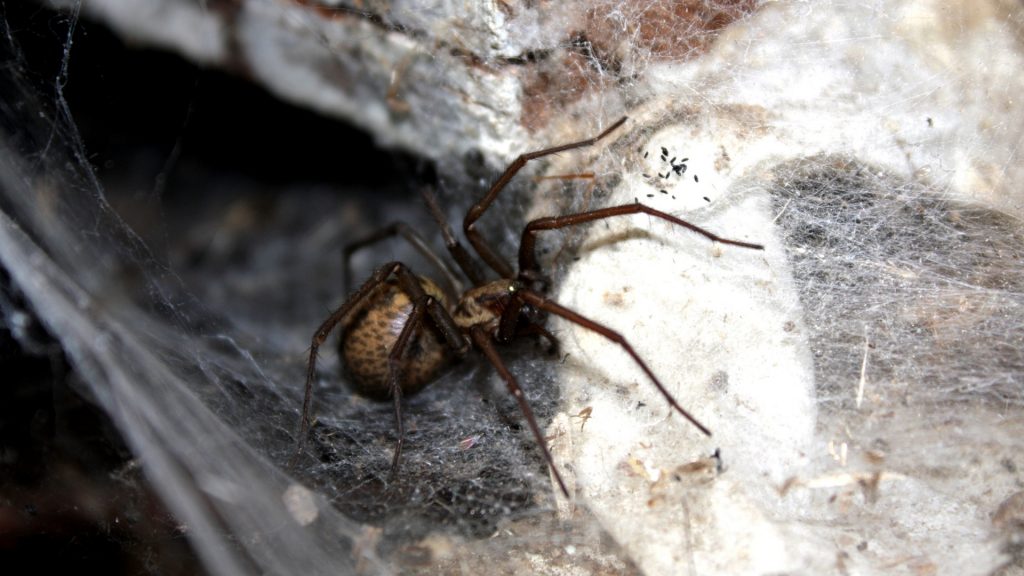
Hobo spiders often come into human households in late summer and early fall, when they mate and lay eggs. Hobo spiders are much more likely to enter your home if you have an insect infestation.
They also look for warm places to wait out the winters, so keep an eye out for them when the weather gets colder.
How To Get Rid of Hobo Spiders? Step by Step Instructions
If you have hobo spiders in your home, for sure, you want to get rid of them. Luckily, hobo spiders can be killed using several methods, but first, you will have to ensure no more get in.
To get rid of hobo spiders:
- Seal cracks and holes in walls or foundations.
- Repair broken window screens and seal the bottom edges of doors.
- Seal gaps in attics and cover unscreened windows with plastic and duct tape.
- Clear any debris where hobo spiders might hide beneath furniture, in your yard, and piles of boxes or clutter.
- Place sticky traps near doors, under windows, and beneath existing webs.
- Vacuum up webs, egg sacs, and spiders and seal the vacuum bag in an airtight plastic bag before disposing of it.
- Always kill hobo spiders when you see them, preferably using a long-range fly swatter or a shoe.
- Store clothes and other things that hobo spiders could hide in, in plastic bags or sealed containers.
- Sprinkle diatomaceous earth around your home to keep hobo spiders out, as well as in dark areas like on closet floors, attic floors, beneath furniture, and anywhere else you have seen a web.
- Invest in other pest control like a bug zapper, flypaper, or a long-lasting insecticidal spray to eliminate food sources for hobo spiders.
- Use curtains at night and keep unused lights off to keep other insects from coming too close to your home.
How Do I Get Rid of Hobo Spiders in Some Specific Places?
If you want to eliminate your hobo spiders, you must treat specific areas where they make their webs. If you keep them out and kill those who don’t leave, you should be able to eradicate them quickly.
To get rid of hobo spiders in your home, basement, or yard, you will need to make sure that the area is inhospitable to spiders and other insects, remove as many webs as you can, set traps, and use diatomaceous earth to kill them.
So, let’s go through all of the steps so you won’t have to see another hobo spider in your favorite spot again.
Related: Outdoor Spider Control: 7 Best Outdoor Spider Sprays Review
How To Get Rid of Hobo Spiders in Your Home?

To get rid of hobo spiders in your home:
- Make sure there is no way for more insects or hobo spiders to enter your home by sealing off windows, repairing cracks in walls and floors, and sealing doors well.
- Vacuum up as many hobo spiders, eggs, and webs as you can find, checking in the hard-to-reach spaces that they love to breed and lay eggs in.
- Sprinkle diatomaceous earth anywhere you have seen webs or hobo spiders, as well as around your home, making an anti-insect and anti-spider barrier.
- Place sticky traps anywhere you have seen a hobo spider, under windows, close to doors, and beside vents.
- Kill every hobo spider you see to keep it from reproducing.
How To Get Rid of Hobo Spiders in Basement?
To get rid of hobo spiders in your basement:
- Seal off all entry points like windows, holes in the foundation, and cracks in walls.
- Ensure there are no holes in your window screens.
- Check that your doors fit well, and have a rubber or silicone seal at the bottom and top to keep spiders out.
- Vacuum up webs, egg sacs, and spiders, paying particular attention to small cracks and crevices under furniture and between objects.
- Sprinkle diatomaceous earth on the floor, putting a little extra underneath and around existing webs.
- Invest in a bug trap like a bug zapper or chemical insecticide to kill off hobo spiders’ food sources.
- Place sticky bug traps near doors, windows, and around existing webs.
How To Get Rid of Hobo Spiders Outside?
To get rid of hobo spiders outside:
- Sprinkle diatomaceous earth around woodpiles, stones, bricks, shrubs, and other hiding places.
- Keep your yard clear of clutter where hobo spiders could hide.
- Mow your lawn regularly to keep hobo spiders from making webs in your yard.
What Deters Hobo Spiders?

Perimeter sprays, insecticide sprays, and diatomaceous earth deter and kill hobo spiders quickly and keep them out for good. If you want to get rid of hobo spiders, you will need something that works quickly and lasts a while before you have to reapply.
If you want to send spiders running from your home, you will want to use the very best products. That’s why we’ve put together a list of the go-to sprays and insecticides effective for beating hobo spiders.
Related: Diatomaceous Earth Uses as a Natural Pesticide
What Spray Kills Hobo Spiders?
Here are two of the best sprays from Amazon that can kill hobo spiders:
Best for Keeping Hobo Spiders Out: Ortho Home Defense Indoor and Perimeter Spray
- Ortho Home Defense Insect Killer for Indoor & Perimeter2 is a bug...
- Provides a long-lasting bug barrier of up to 12 month protection...
- Apply this pesticide anytime as a preventative treatment or after...
- Use this pest control spray with confidence indoors (kitchens,...
- The easy-to-use continuous spray Comfort Wand helps you control...
When it comes to hobo spiders, you will always want a quick, foolproof fix that will get rid of your pests for a long time. That’s why we always recommend Ortho Home Defense Indoor and Perimeter Spray.
This is good for so many different insects. It works so well against spiders, including hobo spiders, brown recluses, and black widows. Additionally, it works against over 130 other pests like fleas, ticks, flies, beetles, roaches, and ants.
It is also safe enough to use indoors and outdoors, so you won’t need two different chemicals. This one does it all.
Best on-Contact Spray: Terro Spider Killer Spray
- 2 spray bottles
- Kills spiders (including Black widow, brown recluse and hobo...
- Kills on contact
- Can be used indoors and outdoors
If you ever see a hobo spider where it doesn’t belong, reach for Terro Spider Killer Spray. This spray only works on spiders when you spray them directly, but since you can use it while still keeping your distance from the spider, this is highly recommended, especially if you don’t want to get close enough to squash a hobo spider.
You can direct this spray at webs, shoot some in cracks and crevices where you have seen hobo spiders, or keep it on hand if you cross paths with a creepy crawler.
Best Insecticide for Hobo Spiders
For almost any non-flying insect, we cannot recommend DiatomaceousEarth DE10 from Amazon enough. It’s not a chemical, but it is made up of fine silica crystals that pierce the skin of insects and spiders.
- OMRI Listed - Listed with the Organic Minerals Research...
- Natural Product - Composed of 10lbs of 100% ground freshwater...
- Vegan-Keto-Gluten Free
- Diatomaceous Earth is a natural source of freshwater amorphous...
It’s food-grade, and some people even mix this stuff with water and drink it as a health tonic! In any case, use it to kill all kinds of insects that crawl close to the ground, including hobo spiders. You will never have to worry about your pets and children when you use it since it is safe and protects them from harmful spiders.
Related: Best Insecticide Dust for Ants
How To Get Rid of Hobo Spiders Naturally?
To get rid of hobo spiders naturally:
- Mow your lawn regularly and keep everything trimmed to keep spiders from making webs.
- Move wood piles away from your home.
- Use diatomaceous earth anywhere that spiders might hide, like under ornaments, in bushes, or in crevices in walls or flower beds.
Best Home Remedies To Get Rid of Hobo Spiders
You might want to make a natural spider repellent if you live in an area where hobo spiders are prevalent. You can make a citrus and vinegar spray for hobo spiders to treat windowsills, baseboards, doorways, and your stone walls.
To make citrus vinegar spray, mix in a spray bottle:
Step 1: 1 cup of white vinegar
Step 2: 2 orange peels
Step 3: ¼ cup water
Let the mixture sit overnight, then remove the orange peels. Now, you have a fresh-smelling spray that repels spiders of all kinds.
How To Keep Hobo Spiders Out of the House?
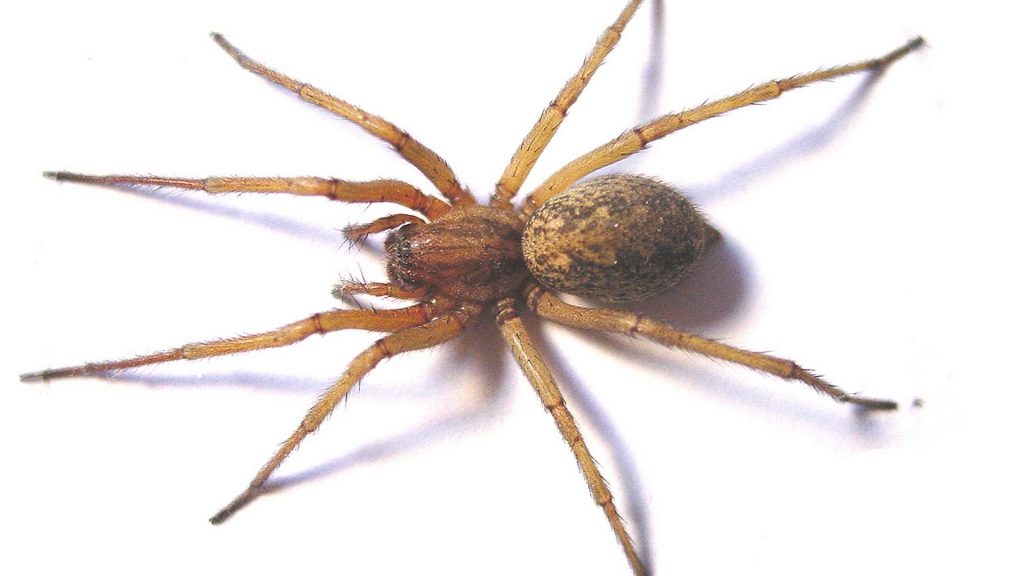
To keep hobo spiders out of your house, you will need to ensure that all possible entryways are sealed well. Check for gaps around doors, windows, baseboards, vents, and foundations and fill them with silicone caulk.
You will also need to make a perimeter with an insecticide like Ortho Home Defense Indoor and Perimeter or DiatomaceousEarth DE10.
Can Exterminators Get Rid of Hobo Spiders?
Exterminators can get rid of hobo spiders. Calling a professional is sometimes necessary, especially since most exterminators are well-educated and experienced with local pests like hobo spiders.

Related: What Chemicals do Exterminators Use for Ants?
Summary
If you think you have found a hobo spider in your house, make sure that you have not misidentified it. Hobo spiders live in a small region in the pacific northwest, have eight eyes, cannot climb much, and spin funnel-shaped webs. Getting rid of them is essential since they may be venomous.
The best methods include using diatomaceous earth, insecticides, and sticky traps. Also, sealing your home to exclude them is crucial for eradication.
List of Sources
Davis, R. (2008). Hobo Spiders. Utah State University.
Vetter, R. S. (2006). Hobo Spider. University of California.
Jochum, J. (2013). The Hobo Spider. University of Wisconsin Bioweb.
Bennett, R., Vetter, R. (2004). An approach to spider bites. Erroneous attribution of dermonecrotic lesions to brown recluse or hobo spider bites in Canada. US National Library of Medicine.
- How to Get Rid of Copperheads | Practical Guide - August 27, 2023
- How to Get Rid of Corn Snakes | What Makes Them Aggressive? - August 27, 2023
- How to Get Rid of Alligators | Safety Measures and Removal Methods - July 16, 2023



